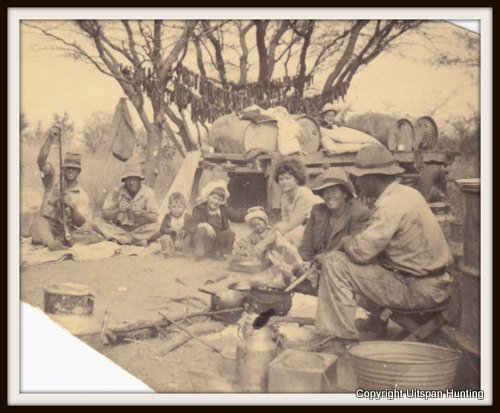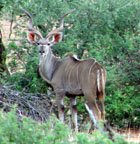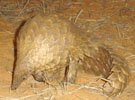For more information about our hunting safaris, don’t hesitate to reach out and contact us!
Rhino Hunt
by Glen Eaton
(Sultan, WA, USA)
Not a normal hunt where I would stand back fifty to a hundred meters and shoot him with a very large rifle. On this hunt I will have to stalk within ten meters and shoot the rhino with a tranquilizer dart.
I call a hunting friend to tell him that I am going back to Africa. Before I can say more Chris warns me to stay away from Rhinoceros.
He has just read a book where the Rhino is described as about the most dangerous animal in Africa. I tell him that the dart will put the rhino to sleep . . . in about a half hour. What am I doing?
I get down my copy of Africa Hunter II and read about a darted Rhino charging the darter. I correspond with my PH; he says that the Rhino usually runs away but if he should charge he is backing me up with a .375. A .375! What I want is a .700 Nitro Express.
During the next year I discuss the hunt and all the possibilities with my friends and my wife. She is a bit apprehensive and asks me if I want to back out.
But I can't. I'm not a coward. A man's got to do what a man’s got to do.
When we - my wife Karen and I - arrive in Africa, the PH tells me that he wants to move two Rhino. Would I like to dart both of them? Of course I will. Two chances to die for the price of one.
Darting Rhinos is a large operation, especially if the Rhinos are to be moved to another location. A helicopter and pilot, two large trucks to carry the Rhinos and safari vehicles to carry the PH, hunter, veterinarian, observers and a dozen or more strong men to handle the Rhino after he has been sedated.
We all meet at the farm where the veterinarian loads a few darts with water so that I can learn to shoot the darting rifle. It is easy. Just get very close to the target, aim and pull the trigger.
The water in the darts is replaced with a powerful sedative... so powerful that a very small amount will kill a man. We are very careful as we handle the darts.
We drive from water hole to water hole looking for the Rhino. There are only two on the farm. We are moving both of them. Karen and I are enjoying the ride. We are seeing many animals. None of them are Rhinos. We hunt for two hours then decide to use plan B. I will hunt from the helicopter.
This will be a new and exciting experience for me. It is my first helicopter ride! The door is removed from the helicopter and I am strapped into the rear seat. Just a seat belt, no shoulder harness - I must lean out the door to fire the dart.
Then we are airborne. I see every kind of animal that lives on the farm as we fly a search grid looking for the Rhinos. It is wonderful. We search for thirty five minutes before we find them.
The pilot begins his shooting run, flying a few meters above the Rhino, dodging trees as we go. I lean out the door, take aim and fire. The dart hits the Rhino high on the rump.
The pilot calls the ground crew to alert them for the recovery. The radios don't work. We must leave the Rhino, find the ground crew, land and tell them to follow us. We hunt for several minutes to find the Rhino. He is still running. The helicopter is used to herd the Rhino towards the recovery trucks. It is essential that he falls in an area that is accessible.
It seems like forever but the Rhino is slowing, staggering occasionally, finally falling. The recovery crew rushes to his side, holding him upright. He will suffocate if he falls on his side.
We land nearby and I run over so that we can take pictures and measure the horns. The veterinarian administers part of the antidote — enough to get the Rhino moving but not so much that he cannot be controlled.
Now the men earn their pay. With ropes and muscles the Rhino is moved up the ramp and into the truck.
The Rhino is given the remainder of the antidote and off we go: the truck to deliver the Rhino and me... in the helicopter to find the other Rhino.
Glen Eaton
Comments for Rhino Hunt
|
||
|
||
|
||
|
||
|
||
|
||
|
||
|
||
|
||
|
||
Meaning of "Uitspan"
'Uitspan' is an Afrikaans word that means place of rest.
When the Boer settlers moved inland in Southern Africa in the 1800's, they used ox carts. When they found a spot with game, water and green grass, they arranged their ox carts into a circular laager for protection against wild animals and stopped for a rest.
They referred to such an action of relaxation for man and beast, as Uitspan.

(Picture above of our ancestors.)
Did you know? Greater Southern Kudus are famous for their ability to jump high fences. A 2 m (6.56 ft) fence is easily jumped while a 3 m (9.84 ft) high fence is jumped spontaneously. These strong jumpers are known to jump up to 3.5 m (11.48 ft) under stress. |
to read about my experience...
Did you know? Some animals have one sense more than man!The flehmen response is a particular type of curling of the upper lip in ungulates, felids and many other mammals. This action facilitates the transfer of pheromones and other scents into the vomeronasal organ, also called the Jacobson's Organ. Some animals have one sense more than man!The flehmen response is a particular type of curling of the upper lip in ungulates, felids and many other mammals. This action facilitates the transfer of pheromones and other scents into the vomeronasal organ, also called the Jacobson's Organ.This behavior allows animals to detect scents (for example from urine) of other members of their species or clues to the presence of prey. Flehming allows the animals to determine several factors, including the presence or absence of estrus, the physiological state of the animal, and how long ago the animal passed by. This particular response is recognizable in males when smelling the urine of a females in heat. |




